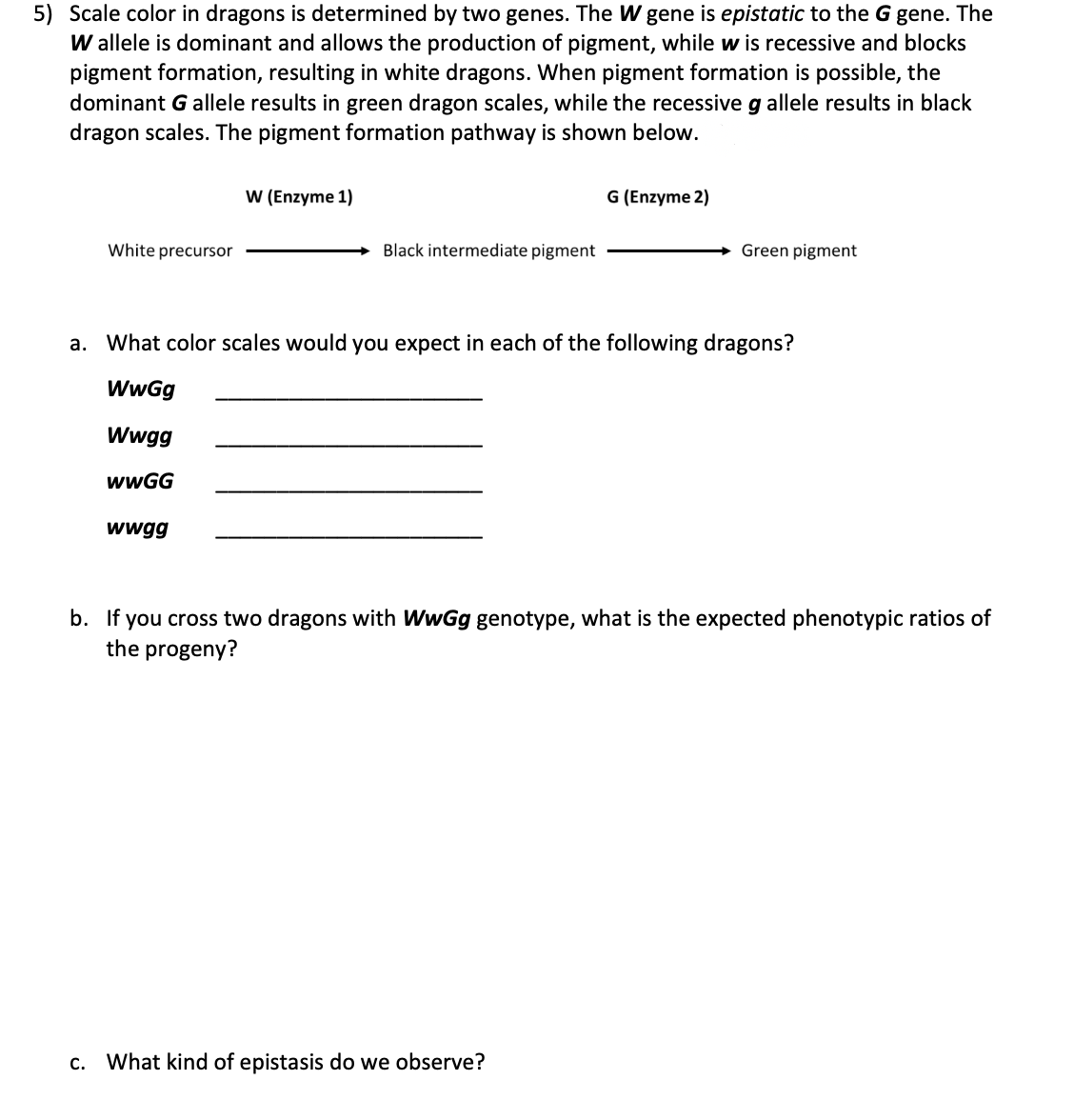5) Scale color in dragons is determined by two genes. The W gene is epistatic to the G gene. The W allele is dominant and allows the production of pigment, while w is recessive and blocks pigment formation, resulting in white dragons. When pigment formation is possible, the dominant G allele results in green dragon scales, while the recessive g allele results in black dragon scales. The pigment formation pathway is shown below. W (Enzyme 1) G (Enzyme 2) White precursor Black intermediate pigment Green pigment a. What color scales would you expect in each of the following dragons? WwGg Wwgg wwgg b. If you cross two dragons with WwGg genotype, what is the expected phenotypic ratios of the progeny? c. What kind of epistasis do we observe?
5) Scale color in dragons is determined by two genes. The W gene is epistatic to the G gene. The W allele is dominant and allows the production of pigment, while w is recessive and blocks pigment formation, resulting in white dragons. When pigment formation is possible, the dominant G allele results in green dragon scales, while the recessive g allele results in black dragon scales. The pigment formation pathway is shown below. W (Enzyme 1) G (Enzyme 2) White precursor Black intermediate pigment Green pigment a. What color scales would you expect in each of the following dragons? WwGg Wwgg wwgg b. If you cross two dragons with WwGg genotype, what is the expected phenotypic ratios of the progeny? c. What kind of epistasis do we observe?
Human Anatomy & Physiology (11th Edition)
11th Edition
ISBN:9780134580999
Author:Elaine N. Marieb, Katja N. Hoehn
Publisher:Elaine N. Marieb, Katja N. Hoehn
Chapter1: The Human Body: An Orientation
Section: Chapter Questions
Problem 1RQ: The correct sequence of levels forming the structural hierarchy is A. (a) organ, organ system,...
Related questions
Question

Transcribed Image Text:5) Scale color in dragons is determined by two genes. The W gene is epistatic to the G gene. The
W allele is dominant and allows the production of pigment, while w is recessive and blocks
pigment formation, resulting in white dragons. When pigment formation is possible, the
dominant Gallele results in green dragon scales, while the recessive g allele results in black
dragon scales. The pigment formation pathway is shown below.
W (Enzyme 1)
G (Enzyme 2)
White precursor
Black intermediate pigment
→ Green pigment
a. What color scales would you expect in each of the following dragons?
WwGg
Wwgg
wwGG
wwgg
b. If you cross two dragons with WwGg genotype, what is the expected phenotypic ratios of
the progeny?
c. What kind of epistasis do we observe?
Expert Solution
Step 1
Epistasis is also known as non allelic interaction.
It does not follow Mendel's laws.
Step by step
Solved in 2 steps

Knowledge Booster
Learn more about
Need a deep-dive on the concept behind this application? Look no further. Learn more about this topic, biology and related others by exploring similar questions and additional content below.Recommended textbooks for you

Human Anatomy & Physiology (11th Edition)
Biology
ISBN:
9780134580999
Author:
Elaine N. Marieb, Katja N. Hoehn
Publisher:
PEARSON

Biology 2e
Biology
ISBN:
9781947172517
Author:
Matthew Douglas, Jung Choi, Mary Ann Clark
Publisher:
OpenStax

Anatomy & Physiology
Biology
ISBN:
9781259398629
Author:
McKinley, Michael P., O'loughlin, Valerie Dean, Bidle, Theresa Stouter
Publisher:
Mcgraw Hill Education,

Human Anatomy & Physiology (11th Edition)
Biology
ISBN:
9780134580999
Author:
Elaine N. Marieb, Katja N. Hoehn
Publisher:
PEARSON

Biology 2e
Biology
ISBN:
9781947172517
Author:
Matthew Douglas, Jung Choi, Mary Ann Clark
Publisher:
OpenStax

Anatomy & Physiology
Biology
ISBN:
9781259398629
Author:
McKinley, Michael P., O'loughlin, Valerie Dean, Bidle, Theresa Stouter
Publisher:
Mcgraw Hill Education,

Molecular Biology of the Cell (Sixth Edition)
Biology
ISBN:
9780815344322
Author:
Bruce Alberts, Alexander D. Johnson, Julian Lewis, David Morgan, Martin Raff, Keith Roberts, Peter Walter
Publisher:
W. W. Norton & Company

Laboratory Manual For Human Anatomy & Physiology
Biology
ISBN:
9781260159363
Author:
Martin, Terry R., Prentice-craver, Cynthia
Publisher:
McGraw-Hill Publishing Co.

Inquiry Into Life (16th Edition)
Biology
ISBN:
9781260231700
Author:
Sylvia S. Mader, Michael Windelspecht
Publisher:
McGraw Hill Education